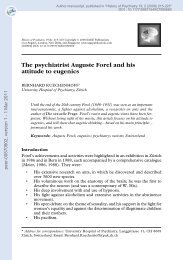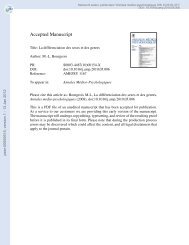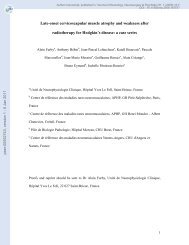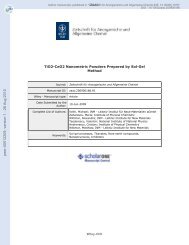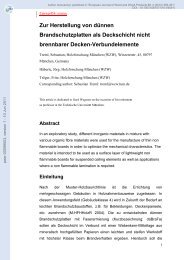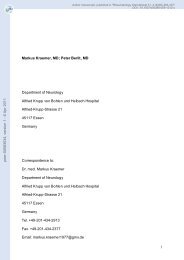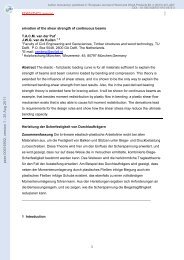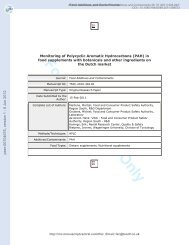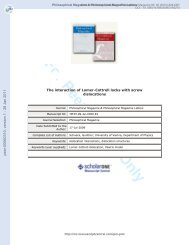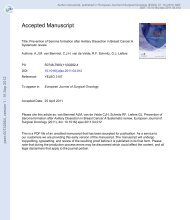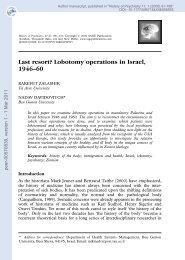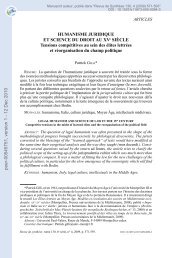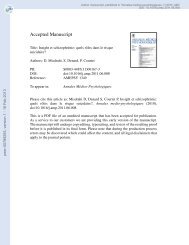Cosheaves and connectedness in formal topology
Cosheaves and connectedness in formal topology
Cosheaves and connectedness in formal topology
Create successful ePaper yourself
Turn your PDF publications into a flip-book with our unique Google optimized e-Paper software.
peer-00821313, version 1 - 9 May 2013<br />
the aim of these notes is to show how some of the ideas can be imported <strong>in</strong>to<br />
predicative <strong>formal</strong> <strong>topology</strong>. At the same time, we hope also to present an<br />
easier <strong>in</strong>troduction to [2] by focus<strong>in</strong>g on the localic case. Our techniques also<br />
have benefit even with<strong>in</strong> topos-valid mathematics. A <strong>formal</strong> <strong>topology</strong> (more<br />
particularly <strong>in</strong> the <strong>in</strong>ductively generated case) is a localic site (or, a frame<br />
presentation by generators <strong>and</strong> relations), <strong>and</strong> the predicative manipulation of<br />
these gives access to the “geometric” techniques described <strong>in</strong> [6].<br />
First, we shall def<strong>in</strong>e the notion of cosheaf over <strong>formal</strong> <strong>topology</strong>. We shall also<br />
describe <strong>in</strong> particular the <strong>in</strong>ductively generated case, s<strong>in</strong>ce the predicative parts<br />
of topos-valid locale theory generally translate first <strong>in</strong>to <strong>in</strong>ductively generated<br />
<strong>formal</strong> <strong>topology</strong>. They come out of the technology of sites, <strong>and</strong> presentations<br />
by generators <strong>and</strong> relations, <strong>and</strong> the full cover is not normally explicitly present<br />
<strong>in</strong> those work<strong>in</strong>gs. The theory of cosheaves over a site is geometric. On the<br />
one h<strong>and</strong>, this is why there is a topos MX whose po<strong>in</strong>ts are the cosheaves<br />
– the topos classifies the geometric theory of cosheaves. On the other h<strong>and</strong>,<br />
it is the geometricity that guarantees predicativity. “Geometric” essentially<br />
means “preserved by <strong>in</strong>verse image functors of geometric morphisms”, <strong>and</strong> those<br />
functors do not preserve the impredicative topos construction of powersets.<br />
Next, we def<strong>in</strong>e <strong>connectedness</strong> for an arbitrary <strong>formal</strong> <strong>topology</strong> <strong>and</strong> show<br />
its equivalence, <strong>in</strong> the overt case, to an earlier def<strong>in</strong>ition. Our def<strong>in</strong>ition uses<br />
an impredicative quantification over covers, <strong>and</strong> we do not know if this can be<br />
reduced to predicative structure, even <strong>in</strong> the <strong>in</strong>ductively generated case.<br />
Next, we look at local <strong>connectedness</strong>. The simplest underst<strong>and</strong><strong>in</strong>g is that<br />
there is a base of connected opens, <strong>and</strong> we characterize those <strong>formal</strong> topologies<br />
for which every basic open is connected as “<strong>formal</strong>ly locally connected”. However,<br />
this depends on hav<strong>in</strong>g a very special base <strong>and</strong> we next move to a general<br />
characterization of when a cosheaf is the connected components cosheaf mak<strong>in</strong>g<br />
a <strong>formal</strong> <strong>topology</strong> locally connected. We describe structure <strong>and</strong> properties for<br />
local <strong>connectedness</strong>, <strong>and</strong> show that a <strong>formal</strong> <strong>topology</strong> has these iff it is homeomorphic<br />
to a <strong>formal</strong>ly locally connected <strong>formal</strong> <strong>topology</strong>. As far as we know,<br />
this characterization is new both <strong>in</strong> <strong>formal</strong> <strong>topology</strong> <strong>and</strong> <strong>in</strong> <strong>topology</strong>. It is worth<br />
not<strong>in</strong>g that one role of the cosheaf is to provide witnesses for a positivity predicate:<br />
a is positive iff π 0 (a) is <strong>in</strong>habited. This also shows that a locally connected<br />
<strong>formal</strong> <strong>topology</strong> is overt. (Of course, the converse is not true. Classically, all<br />
locales are overt, but not all are locally connected.)<br />
After that, <strong>in</strong> the <strong>in</strong>ductively generated case, we look at the notion of complete<br />
spread. This is a central topic <strong>in</strong> [2], <strong>and</strong> we show how some of the ideas<br />
there appear <strong>in</strong> <strong>in</strong>ductively generated <strong>formal</strong> <strong>topology</strong>. Each cosheaf F over<br />
X gives rise to a complete spread, a map CS(X; F ) → X, <strong>and</strong> X is locally<br />
connected, with F the connected components cosheaf, iff this map is a homeomorphism.<br />
We conclude with some remarks on the symmetric topos MX, <strong>and</strong> how one<br />
might hope for an analogue <strong>in</strong> generalized <strong>formal</strong> <strong>topology</strong>. We illustrate the<br />
discussion with a new proof of some results <strong>in</strong> [2], show<strong>in</strong>g that, if X is a space<br />
equipped with a cosheaf π 0 , then X is locally connected with π 0 the connected<br />
components cosheaf iff π 0 is a “strongly term<strong>in</strong>al” cosheaf.<br />
3



